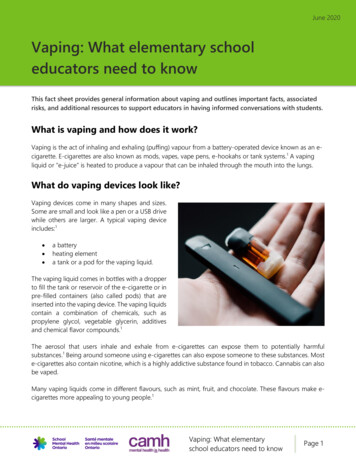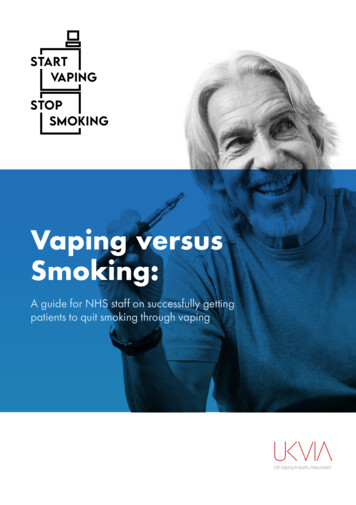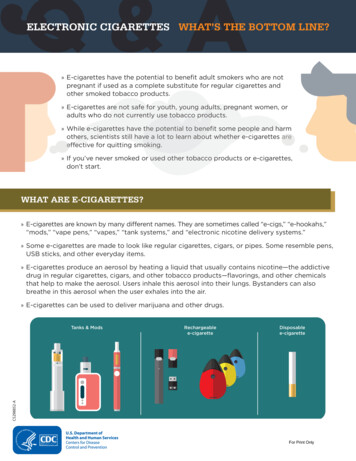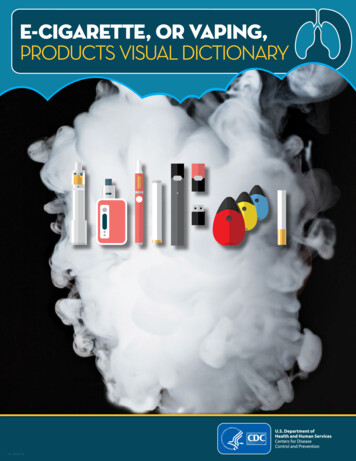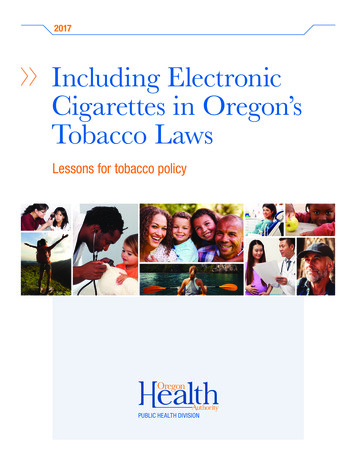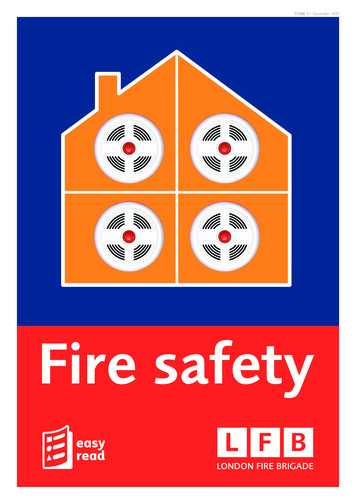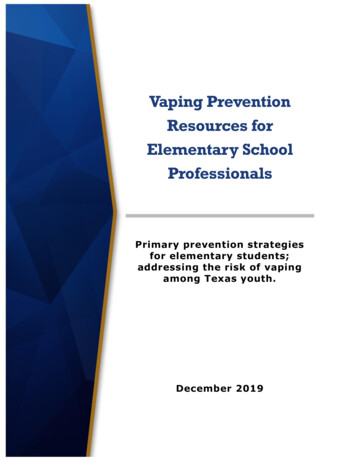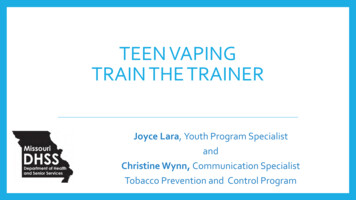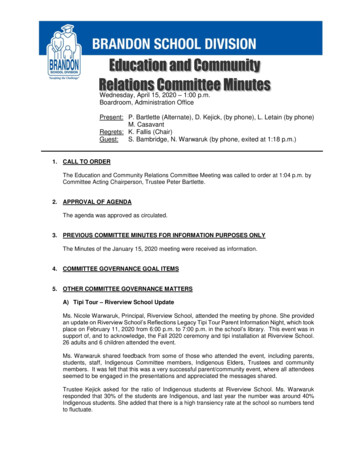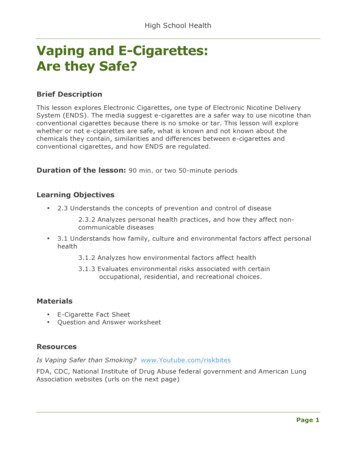
Transcription
High School HealthVaping and E-Cigarettes:Are they Safe?Brief DescriptionThis lesson explores Electronic Cigarettes, one type of Electronic Nicotine DeliverySystem (ENDS). The media suggest e-cigarettes are a safer way to use nicotine thanconventional cigarettes because there is no smoke or tar. This lesson will explorewhether or not e-cigarettes are safe, what is known and not known about thechemicals they contain, similarities and differences between e-cigarettes andconventional cigarettes, and how ENDS are regulated.Duration of the lesson: 90 min. or two 50-minute periodsLearning Objectives 2.3 Understands the concepts of prevention and control of disease2.3.2 Analyzes personal health practices, and how they affect noncommunicable diseases 3.1 Understands how family, culture and environmental factors affect personalhealth3.1.2 Analyzes how environmental factors affect health3.1.3 Evaluates environmental risks associated with certainoccupational, residential, and recreational choices.Materials E-Cigarette Fact SheetQuestion and Answer worksheetResourcesIs Vaping Safer than Smoking? www.Youtube.com/riskbitesFDA, CDC, National Institute of Drug Abuse federal government and American LungAssociation websites (urls on the next page)Page 1
High School HealthInstructional ActivitiesIntroduction and Information:1. Hand out Fast Facts about Electronic Cigarettes factsheet to each student.2. Students read and annotate the factsheet, writing the questions they have aboutE-Cigarettes on the Question and Answer worksheet.3. In table groups, students brainstorm the questions they want to research.4. Class shares out their questions. Teacher records the questions and organizesthem by topic on the whiteboard.Class activity:1. Assign Questions to student pairs or table groups, choosing a range of topicsfrom the factsheet.2. Provide acceptable websites (.gov or .org) for research. A challenge toresearching electronic cigarettes is avoiding commercial and “how-to”information. Here are some evidence-based sources of information:a. FDA: http://www.fda.gov/TobaccoProducts/default.htmb. CDC: ends-keyfacts.pdfc. CDC: E-Cigarette use among high school students:http://www.cdc.gov/pcd/issues/2016/15 0564.htmd. National Institute on Drug Abuse rugfacts/electronic-cigarettese-cigarettese. American Lung Association: garettes-and-lung-health.html3. Student groups share their research with the class. Classmates comment or askfurther questions. Presenters try to answer these questions. New questions canbe recorded for further research.Exit ticket: Turn in Question and Answer worksheetPage 2
Fast Facts aboutElectronicCigarettesWhat are e-cigarettes?but not to the toxins from burning that are produced bycigarettes.Electronic cigarettes, also known as e-cigarettes or ecigs, are battery-powered devices designed to look likeand be used the same way as conventional cigarettes.Many Public Health officials agree that e-cigarettes aresafer than smoking conventional cigarettes. However,research shows that smokers who switch to vaping donot tend to quit, or to give up nicotine.Unlike conventional cigarettes that burn tobacco andrelease nicotine into the smoke, e-cigarettes heat up aliquid that contains nicotine and release it as anaerosol.A cartridge in the e-cigarette dispenses the “eliquid”. Another ingredient, propylene glycol, producesthe aerosol, which is stored under pressure. When abutton is pressed, the aerosol is released as a finespray. Nicotine, nicotine-free, and flavored e-liquidsare available.E-cigarettes were invented in China in 2003. Saleshave grown rapidly in spite of questions about safety,effectiveness to help smokers quit, impact on publichealth, and lack of regulation by the US government.The FDA began regulation e-cigarettes in Aug, 2016.What is vaping?Health effects of using nicotine include addiction, highblood pressure, and, later in life, coronary heartdisease and cardiovascular problems. Inhalingpropylene glycol and glycerol irritates the mouth andthroat and causes a dry cough. These ingredients inthe liquid solution will be studied for the health effectsof inhaling the vapor into the lungs.Also, nicotine can cause poisoning, especially forchildren. According to the World Health Organization,if a child swallows the e-liquid in a 24 mg e-cigarettecartridge, it would probably die. Nicotine is especiallydangerous to youth, pregnant and nursing women,people with heart conditions, and the elderly. E-cigsmay increase nicotine addiction among young peopleand lead them to try other tobacco products.Vaping means using e-cigarettes. Vaping copies theexperience of smoking a cigarette by delivering vaporor aerosol to the lungs. The aerosol contains nicotine,propylene glycol, glycerin, and various compositions offlavorings.Is vaping safe?Since the US Food and Drug Administration (FDA)only began to regulate e-cigarettes in 2016, clinicalstudies for safety are not completed. Consumers haveno way to know whether the devices are safe. Thechemicals and their concentration in the e-liquid, andthe dose of nicotine, were not regulated before 2016.We do know that the amounts of nicotine, propyleneglycol, and other ingredients in different brands of ecigarettes vary widely. It is difficult to accuratelymeasure the ingredients and by-products from heatingthe vaping solution. With FDA regulation, manufacturers will have to state the ingredients and how muchnicotine the e-liquid contains.The air concentrations of nicotine from different brandsof e-cigarettes have been found to be about 1/10th theconcentration of secondhand nicotine from smokingcigarettes. However, using e-cigarettes indoors mayexpose others to nicotine. One study found that ecigarettes produce second-hand exposure to nicotineWhat about vaping hash oil?Hash oil is concentrated tetrahydrocannabinol (THC),the psychoactive ingredient in marijuana. Hash oil isextracted from cannabis buds using liquid butane.Vaping hash oil is another way to use marijuana.However, butane is extremely flammable and canexplode. Buildings have caught fire and people havebeen burned when cannabis buds and butane blew upin their faces. School and public health officials areconcerned about young people extracting hash oil andrepurposing e-cigarettes to vape hash oil.
How are e-cigarettes regulated?On Aug 8, 2016, FDA’s regulatory authority began tocover all tobacco products, including vaporizers, vapepens, hookah pens, e-cigarettes, e-pipes, and all otherElectronic Nicotine Delivery Systems (ENDS). FDA willregulate the manufacture, import, packaging, labeling,advertising, promotion, sale, and distribution of ENDS.This action is a milestone in consumer protection.The FDA will now: Review new tobacco products not yet on themarket Prevent misleading claims by manufacturers Evaluate the ingredients and how tobaccoproducts are made Communicate potential risks of tobacco productsDo e-cigarettes help smokersquit or help non-smokers start?The evidence does not suggest that smokers whoswitch to e-cigarettes stop using nicotine. The FDAhas not approved e-cigarettes as smoking cessationaids.E-cigarettes may hook new users on nicotine andencourage them to move on to smoking or chewingtobacco.In 2015, over 3 million middle and high schoolstudents used e-cigarettes, up 22% from 2014. In2014 and 2015, youth used e-cigarettes more than anyother tobacco product. Youth said appealing flavorswere the main reason they use e-cigs.Questions to think about:E-cigarettes were unregulated from 2003-2016. If thehealth effects of vaping were not known, do you thinkallowing e-cigarettes to be sold was the right thing todo?Who besides the people who use e-cigarettes do youthink might be exposed to the chemicals in the vapor?Do you think it is safe to expose non-users to ecigarette vapor? Is it fair?If using e-cigarettes is a gateway to smoking, but alsohelps smokers cut down, do you think e-cigarettescause more harm than good, or vice versa?E-cigarettes and vaping solutionsWhy is it important to regulate?A goal of the FDA is to protect future generations fromthe risks of tobacco use. Laws that authorize the FDAto regulate tobacco products make these products lessavailable and less attractive to youth. Every day, morethan 2,600 kids try their first cigarette and nearly 600kids become daily cigarette smokers. Many youthbecome addicted before they are old enough tounderstand the risks.E-Cigarette ExplosionsAccording to the FDA, 134 incidents of e-cigarettebattery explosions and fires occurred in the USbetween 2009-Jan, 2016. The incidence is likelyunder-reported. Some explosions happen while thebattery is charging. The lithium-ion batteries in ecigarettes must be charged according to manufacturerinstructions using the charger that comes with the ecigarette. Plugging an e-cigarette into a standard USBport to recharge can result in an explosion or fire.The government is beginning to fund research tounderstand who is using e-cigarettes, and why. Use ofe-cigarettes by young people is fairly low, but thenumber of young users has doubled every year. Whydo you think young people are trying e-cigarettes?Where can I learn more?Federal Drug Administration ProductsIngredientsComponents/ucm456610.htmCenters for Disease Control (CDC): E-cigarette UseAmong Middle and High School Studentshttp://www.cdc.gov/tobacco/data tmNewspapers in Education: Marijuana and E-Cigs:Facts teens can use to make healthy E/2016/DepartmentofHealth/E-Cigarette Fires and Explosions. U.S. ads/pdf/publications/electronic tmarhair@uw.edu
High School HealthE-CigarettesQuestion & Answer WorksheetRead and annotate the Fast Facts about Electronic Cigarettes factsheet.Write the 3 questions you have about electronic cigarettes:1.2.3.My Research Question:My name:Partner’s name:My research & notes (continue on back of page):Sources:Page 3
extracted from cannabis buds using liquid butane. Vaping hash oil is another way to use marijuana. However, butane is extremely flammable and can explode. Buildings have caught fire and people have been burned when cannabis buds and butane blew up in their faces. School and public health officials are
